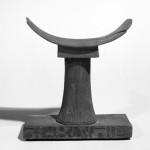Dreams

Sleep and the Sleeping in Ancient Egypt
A recent exhibition on East African headrests indicates that their use represents different levels of symbolic meaning, from marking the significant transition from youth to adulthood, to the more practical function of protecting elaborate hairstyles during sleep; still a factor in the use of headrests in some African tribes today (Fitzwilliam Museum, Cambridge; ‘Triumph, protection and dreams: The East African headrest in context’). Headrests have an iconographical status throughout the African continent and are a recognisable feature of ancient Egyptian culture. The act of sleeping itself is the subject of myth, ritual and superstition interwoven within the religion which permeated all aspects of this complex civilization. Headrests, sleep and dreams are interrelated within Egyptian ideology. Was the Egyptian headrest a purely symbolic object; a funerary essential; an everyday domestic object or an item which fits all of those descriptions? In the following article I will explore aspects of sleep in ancient Egypt, from the headrests used in the act of sleeping, to complex meaning surrounding dreams. [more…]
 By
By